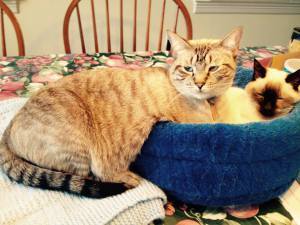Amy Shojai's Blog, page 85
February 2, 2016
SEREN TURNS 20! and Celebrating Valentine’s Day
 Exactly a year ago I wrote a post about how Karma-Kat arrived just in time to celebrate Seren’s birthday. So now the pair of them share a birthday and gotcha-day, and yesterday (well, it’s the date we chose anyway for her birthday…)
Exactly a year ago I wrote a post about how Karma-Kat arrived just in time to celebrate Seren’s birthday. So now the pair of them share a birthday and gotcha-day, and yesterday (well, it’s the date we chose anyway for her birthday…)
SEREN’S 20 YEARS OLD!
In fact, ever since the boy-kitty arrived, Seren’s turned back the clock and today is more active and engaged than when she was 16. She’s still my dainty princess…I can’t imagine life without her.
It seems appropriate to celebrate our special brand of love for Valentine’s Day, in honor of Seren and Karma, and all the kitties that make our lives complete. Want a free book? keep reading!
CAT FACTS CONTEST & GIVE AWAY!
In honor of Seren’s inspiration over 2 decades, I’ve launched a contest give-away of FIFTY (50) E-COPIES my newest book CAT FACTS. I’ll be giving away some coupon discount codes, too.
This is a new kind of contest–and winning is completely in YOUR paws. The entrants who shares the contest the most times and garner the most referrals wins. That simple, just share the paw-some opportunity for a free cat book with your cat loving peeps. You’ll get your own individual URL to share when you click here to enter your email for the contest here.
Go ahead and check out the link–you’ll see a digital preview of the book, too, so you can see what it will look like on your Kindle or iPad, with all the color pictures and suchlike.
And if you’d prefer the print copy of the book, your entry also qualifies you for a chance to win a $5 discount code for the print version. Click HERE to enter & get your unique URL code to share.
Seren and Karma inspired the CAT FACTS book, and I guess you could say that I spent my last 20 years with Seren by my side researching this book. Now it’s time to share the Valentine’s Day kitty love with this CAT FACTS contest.
WHAT REVIEWERS SAY ABOUT CAT FACTS
“It covers every medical and behavioral issue you can possibly think of in alphabetical order with symptoms, first aid, home care, holistic help (LOVE THIS FEATURE!!!), vet care and prevention…”
“This book is, by far, one of the most comprehensive books about cat health topics I have read…”
“The graphics are gorgeous. Very all-inclusive information. Owners, shelters and rescues need to have this book at the ready on their shelves.”
“…you will find over 200 entries culled from Shojai’s 25+ years of experience and her interviews with more than 400 veterinarians on all matters related to feline health and well being.”
THE CLOCK IS TICKING…
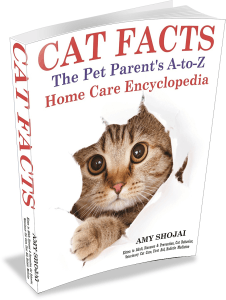 Be sure to enter before the contest closes at midnight February 14, 2016. The 50 winners will be selected by the nifty software that measures shares and referrals, and sent the download link for EPub, mobi and PDF files, which will be available through the end of the month to the winners. And then the remaining top share entrants will receive their $5-off discount code for the PRINT version.
Be sure to enter before the contest closes at midnight February 14, 2016. The 50 winners will be selected by the nifty software that measures shares and referrals, and sent the download link for EPub, mobi and PDF files, which will be available through the end of the month to the winners. And then the remaining top share entrants will receive their $5-off discount code for the PRINT version.
For all the peeps interested, I’ll share the results of the contest in a future blog, too–even perhaps a how-to so you can use the same strategy for a cause close to your heart.
How do YOU celebrate your cats’ birthdays and gotcha days? Karma’s playing “surfing cat” while I drag him around the carpet on a towel. Seren’s getting extra scritches and treats (Karma, too, of course).
But for me, that’s a birthday and Valentine’s that I get to celebrate all year long.

Subscribe to Amy’s YouTube Channel
I love hearing from you, so please share comments and questions. Do you have an ASK AMY question you’d like answered? Do you have a new kitten and need answers? Stay up to date on all the latest just subscribe the blog, “like” me onFacebook, and sign up for Pet Peeves newsletter. Stay up to date with the latest book give aways and appearances related to my September Day pet-centric THRILLERS WITH BITE
January 28, 2016
#Thrillers Thursday: Brendan Rielly AN UNBEATEN MAN

Chills, thrills and spills with Thriller Thursday by Amy Shojai
THRILLER THURSDAY is a new occasional feature of Bling, Bitches & Blood. As a member of International Thriller Writers and alumni of the ITW Debut Author Program, it is my honor to showcase select ITW authors and books participating in the ITW Bloggers Program. If you love reading great books as much as I do, check out my guest BRENDON RIELLY!
 An Unbeaten Man is Brendan Rielly’s first thriller. Brendan is a member of ITW and Maine Writers & Publishers Alliance and studied advanced fiction writing while attending law school. Brendan is chair of Jensen Baird’s litigation department and lives with his wife and three children in Westbrook, Maine, where he is the City Council President. Brendan is the middle of three generations of Maine authors with his father and son (as a high school senior) also published. Check out Brendan Rielly’s author page here and be sure to LIKE him on Facebook.
An Unbeaten Man is Brendan Rielly’s first thriller. Brendan is a member of ITW and Maine Writers & Publishers Alliance and studied advanced fiction writing while attending law school. Brendan is chair of Jensen Baird’s litigation department and lives with his wife and three children in Westbrook, Maine, where he is the City Council President. Brendan is the middle of three generations of Maine authors with his father and son (as a high school senior) also published. Check out Brendan Rielly’s author page here and be sure to LIKE him on Facebook.
I met Brendan (in the *virtual* sense) through the International Thriller Writers. We are both members of the “blog-icity” team for the organization, and one of the perks is we get to read each other’s books. And hey, I just found out he was born in South Bend, Indiana, not too far from Elkhart/Bristol where I grew up. Small world, eh? (Of course, now he’s in Maine and I’m in Texas so not sure what that means). 
Now, my TBR pile teeters dangerously toward the ceiling and my taste in thrillers runs more toward the medical and action/adventure rather than espionage. I’m also a bit leery of Middle East/terrorist type plots (some of y’all know why) so I put off starting the book.
But no worries there…HOLY CATS within the first few paragraphs, the story grabbed me by the throat (in a good way!) and never let go, AN UNBEATEN MAN sucked me into this race-against-time of global proportions. I’m surprised the main character Michael McKeon survives either physically or emotionally, after what he goes through, and the reader continues to root for him all the while knowing he simply can’t overcome the odds…and yet someone “keeps on ticking.” And guess what? the satisfying ending makes it clear that this is just the beginning of what promises to be a fantastic series. BRAVO!
I can see why Douglas Preston offered such a glowing quote for this debut novelist. Be sure to check out other reviews from the likes of Steve Berry, Gayle Lynds and more on this page.
“An Unbeaten Man is a first-class thriller that starts with a fascinating premise—that a microbe can destroy petroleum stocks—and spins into a story of international intrigue, suspense, and maximum mayhem. This well-crafted novel offers compelling characters, believable science, exotic settings, and plenty of surprises. Highly recommended!” –Douglas Preston, #1 bestselling author of The Kraken Project and Blue Labyrinth
Abandoned by his father, orphaned by his drug-addled mother, and devastated by the murder of his sister, Michael McKeon was once a hardened “street dog who learned to play in traffic.” Years later, Michael is now a Bowdoin College professor with a wife and adopted daughter. When he creates a microbe that instantly cleans up any oil spill, no matter how large, by devouring the oil, that discovery should be the breakthrough that defines a career. But the microbiologist’s life is ruined when The Global Group kidnaps his wife and daughter, forcing him to use his microbe to destroy all Saudi and Russian oil. As Michael races against the clock to save his family, he becomes a threat to the secret efforts of the American, Russian and Saudi governments to douse the flames in the Middle East by implementing a new Marshall Plan.
Haunted by the loss of one family and determined not to lose another, Michael will do anything to save his wife and daughter, even if it means throwing the world into chaos. And heaven help anyone, even his own government, who tries to stop him. From the moment Michael’s family is kidnapped, the action never stops, propelling him relentlessly from Bowdoin College’s deceptively tranquil campus in Brunswick, Maine, to a hidden laboratory in the United Arab Emirates; to Abqaiq in the desolate and unforgiving Empty Quarter; to the bitter isolation of the Sakhalin Island oil fields off Russia’s far eastern coast; and to the final showdown in an isolated dacha outside Moscow, where Michael may not survive the ultimate betrayal of discovering who is really behind The Global Group.
Down East Books is the go-to source for books about Maine, and an imprint of Globe Pequot, the trade division of Rowman & Littlefield. AN UNBEATEN MAN published November 2015 | Hardback $24.95 | 6×9 | 260pp. (NOOK Ebook $11.99)
BUY THE BOOK on all fine book venues including Amazon and Barnes & Nobel

Subscribe to Amy’s YouTube Channel
I love hearing from you, so please share comments and questions. Do you have an ASK AMY question you’d like answered? Do you have a new kitten and need answers? Stay up to date on all the latest just subscribe the blog, “like” me onFacebook, and sign up for Pet Peeves newsletter. Stay up to date with the latest book give aways and appearances related to my September Day pet-centric THRILLERS WITH BITE!
January 25, 2016
Amy Shojai Joins Cat Friendly Practice Advisory Council

Cat Friendly Practices make exam times fear free for cats.
I am so honored to have been asked to serve on the Cat Friendly Practice Advisory Council, along with over 60 other cat care professionals. You can see the full CFP Advisory Council list here, and it reads like a who’s who among the cat community! This is a volunteer position, and I’m not being compensated for this post…other than in terms of feeling good about promoting a PAW-some program.
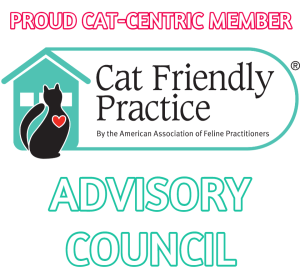 As a member of this group, from time to time I’ll share information that will benefit you, your veterinarian–and most of all, that furry wonder dozing right now in your lap.
As a member of this group, from time to time I’ll share information that will benefit you, your veterinarian–and most of all, that furry wonder dozing right now in your lap.
What is a Cat Friendly Practice? Take a look at the video, below, for more details and click here to take you directly to the American Association of Feline Practitioners to find out how to find your Cat Friendly Practice.
 I love hearing from you, so please share comments and questions. Do you have an ASK AMY question you’d like answered? Do you have a new kitten and need answers? Stay up to date on all the latest just subscribe the blog, “like” me onFacebook, and sign up for Pet Peeves newsletter. Stay up to date with the latest book give aways and appearances related to my September Day pet-centric THRILLERS WITH BITE!
I love hearing from you, so please share comments and questions. Do you have an ASK AMY question you’d like answered? Do you have a new kitten and need answers? Stay up to date on all the latest just subscribe the blog, “like” me onFacebook, and sign up for Pet Peeves newsletter. Stay up to date with the latest book give aways and appearances related to my September Day pet-centric THRILLERS WITH BITE!
Share this:
!
January 19, 2016
SHOW AND TELL: Making Of A Video Book Trailer
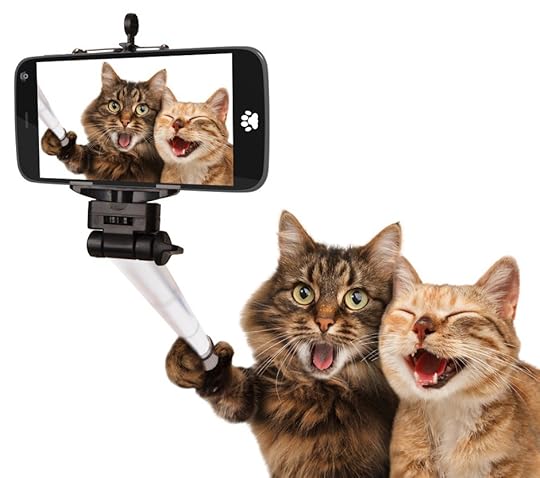 I’ve had a lot of fun cobbling together trailers for my most recent thrillers. And today, I want to share how I put the trailer together, and also added “click-able” links to the video. In other words, pull the curtain aside just a bit for readers, and also for other book writers.
I’ve had a lot of fun cobbling together trailers for my most recent thrillers. And today, I want to share how I put the trailer together, and also added “click-able” links to the video. In other words, pull the curtain aside just a bit for readers, and also for other book writers.
A book trailer is no different than one created for a movie: short, full of impact-icity, and designed to entice or even compel viewers to BUY the book. There’s debate on how much benefit (if any) book trailers have on sales, but heck–more eyeballs and ears just learning about SHOW AND TELL could potentially help.
It’s a given that the book must be good. And it’s a given that it should be available as widely as possible. Those two aspects must happen for the book to garner positive reviews–which also serve to convince readers your book is worth the purchase.
The real unicorn-rainbow-dust is obtaining DISCOVER-ABILITY. I suspect a well-done and compelling book trailer can help.
RULES FOR BOOK TRAILERS
There’s no real “rules” about trailers. Just put yourself in the viewer’s seat and take notes. 1. What makes YOU “click” on the video on YouTube or wherever, 2. What makes you STOP watching before it’s done? 3. What makes you watch to the end? 4. After viewing, what makes you A. like/share/recommend B. take the next step (click/buy/subscribe/whatever).
Based on that, I now strive for 1. Click-able cover image 2. Succinct (under 90 seconds…60 is better!) 3. Tension (what happens next? use the CLIMAX scenes of plot, not the whole story) 4. Value added…in my case, free sample chapter
I don’t pretend to be a whiz or professional at movie-making the way many of my actor and producer colleagues are, but for a DIY super-low-budget project, I’m pretty pleased. Using the criteria in the previous paragraph, I’d love your feedback. Does it make you want to click/watch? Did you watch to the end? Would you “click” the link at the end for the free read? (We’ll get to how it was made, including the click-able link, so please keep reading!).
Did you see the clip with Magical-Dawg? Hey, he had to be in there somewhere, since he’s the inspiration for Shadow, my hero-dog character. You can read more about that in this fun blog post.
One of the so-called “rules” is to keep the video short. Apparently, today we’re all ADD-voyeurs with such short attention spans that—–> OOOOH SQUIRREL!
Although now it’s a single video complete with sound, it didn’t start out that way. If you want, watch again and see if you can count how many separate videos, pictures, and sound cues were used to create this final product. Post your guesses in the comments, and I’ll reveal the answer later. *s*
My first attempt at a trailer was nearly 2-1/2 minutes long, yikes! but it’s had over 500 views so I guess folks liked it well enough. For LOST AND FOUND trailer, I shot nearly all the video myself, (some of it OF myself!) and recorded the voice over but purchased the gunshot sound effects. So other than the cost of the software, which I already had, the first video was nearly free. *s* I’ve included that video further down the page, for those interested.
The trailers for the two latest books HIDE AND SEEK and SHOW AND TELL cost more because I purchased more stock video and audio. There are free-share sites for this but be careful of licensing and copyright issues. Authors don’t want books pirated, so we must respect the rights of the photographer/videographer/model/actor. I purchased several clips from DepositPhotos.com (yes, they have video, too). I think that I paid $30 for “web rights” version for each clip I purchased from them. So each of these videos cost me about $100.
My book trailer for HIDE AND SEEK (also included toward the end of the post) not only used sound effects but also mood-enhancing music, and I tried to time the musical emphasis with appearance of the subtitles. For thrillers, I think that works well. Other genres probably it wouldn’t matter quite so much.
In fact, most book trailers I’ve seen consist of still pictures representing characters or setting with captions that sketch the high points of the plot. There are folks able to make these types of trailers compelling, but I’m not that talented. I prefer video to still pictures, and I prefer voice overs to captions. Probably using a combination works best because reading vs listening is more (or less) compelling and memorable depending on the individual. Today with the advent of SmartPhones and easy-to-record video, you can often shoot the video and images you need yourself–and do the whole thing for free.
But once you have all the different 10-second clips of images, settings, characters and actions, how do you put them together? Video software, of course.
VIDEOPAD EDITING SOFTWARE
There are many kinds of software packages that are easy to use, often free, and provide the effects you’ll want. A simple slide show with captions works well, and can be uploaded to YouTube or Vimeo or other host services (even directly to FaceBook) to leverage share-power.
I discovered VideoPad editing software several years ago, and first downloaded the trial version and fell in love. Using the VideoPad freeware, I produced dozens of my short Ask Amy cat and dog behavior videos and several hundred others all available on my YouTube channel here. When you take a look at some of these, you’ll notice the same intro for each (with puppies or kitties added, depending on the subject), so often you can create your own “stock” footage to use time and again.
Here’s how it works. You open the software, click the “add” button to upload images or video clips or audio files, and then drag/drop into various “tracks.” You can layer these as you wish, move them around, create fade in/fade out or other (zoom!) transitions between these components. The audio track runs below the image files so you can time them, and see where (57 second mark) something happens to create your caption to appear/disappear where you wish. I love this software! You can then “export” the file into any of several formats. The MP4 format works for YouTube very well, but you could expert as a .MOV or any of several other options, including low or high definition, save the file to DVD or whatever you’d like. Brilliant!
Stay tuned for future how-to webinars with screen shots and more for DIY trailers, and other writer-icity topics. Yeah, I don’t have enough to do with the books…I gotta add webinars, too. 
January 14, 2016
#Thrillers Thursday: H.A. Raynes NATION OF ENEMIES

THRILLER THURSDAY is a new occasional feature of Bling, Bitches & Blood. As a member of International Thriller Writers and alumni of the ITW Debut Author Program, it is my honor to showcase select ITW authors and books participating in the ITW Bloggers Program. If you love reading great books as much as I do, check out my first spotlight guest HOLLY RAYNES!

H.A. RAYNES was inspired to write NATION OF ENEMIES by a family member who was a Titanic survivor and another who escaped Poland in World War II. Combining lessons from the past with a healthy fear of the modern landscape, this novel was born. A longtime member of Boston’s writing community, she was a finalist in the Massachusetts Screenwriting Competition and has published a short story in the online magazine REDIVIDER. H.A. Raynes has a history of trying anything once (acting, diving out of a plane, white water rafting, and parenting). Writing and raising children seem to have stuck.
 It’s all about the genetics. DNA. Black & white.
It’s all about the genetics. DNA. Black & white.
A decade ago the US government mandated that all citizens be issued biochips containing all of their medical information and an ID number indicating a person’s health. Then they made the information public—the implications of which were wide-spread and devastating.
Now on the eve of the 2032 presidential election, the country is deeply divided and on the brink of civil war. But as the two major political parties face off, innocent Americans are dying at the hands of masked terrorists. When the Liberty Party’s presidential nominee is assassinated in a highly-coordinated, masterful attack, it sets off a chain of events that will change the course of history and leave America’s inalienable rights—life, liberty, and the pursuit of happiness—dangling on the precipice of extinction.
FIND OUT MORE ABOUT H.A. RAYNES!
Listen to Holly Raynes in this radio show (along with some other fine ITW authors).
Connect with Holly at these links:
http://twitter.com/hollyiswriting
BUY THE BOOK!
NATION OF ENEMIES, Paperback & Ebook, 528 pages
HarperCollins/Witness Impulse Imprint
An Amazon reader: “Nation of Enemies is a tightly wound look into a plausible view of the future of America. Topics being debated today (NSA overreach in surveillance, electronic health records, technology in general, domestic terrorism, refugee screening and more) are woven together to paint a picture of a not too distant future where the concept of what freedom in America really means is tested and defined. The story is told in a the form of an action thriller that keeps you interested and invested from the first page.”
Disclosure: I am not being compensated for this post, and the featured author is not responsible for the content. THRILLER THURSDAY posts may include amazon.com affiliate links for which I’m nominally compensated.
I love hearing from you, so please share comments and questions. Do you have an ASK AMY question you’d like answered? Do you have a new kitten and need answers? Stay up to date on all the latest just subscribe the blog, “like” me on Facebook, and sign up for Pet Peeves newsletter. Stay up to date with the latest book give aways and appearances related to my September Day pet-centric THRILLERS WITH BITE!
January 8, 2016
Enter the Cat Writers Contest, Win $11,000 in Awards & More
Sometimes it pays to be catty—I just finished hosting a Google Hangout On The Air (see bottom of post) about the Cat Writers’ Association annual contest. The international Cat Writers’ Association, Inc. (CWA) founded in 1992 is now accepting entries for its annual Communications Contest with more than $11,000 in prize money plus the prestigious Muse Medallion award in its kitty.
This year, CWA is offering 19 sponsored special awards of $500 to $1,000 each as well as its own Muse Medallions™ to winners in approximately 55 writing, broadcast and graphic arts categories. The special awards cover topics that include veterinary research, health, behavior, nutrition, seniors, kitten care, safety issues, the human-animal bond, humane issues and responsible ownership, plus awards for fiction and new writers.
Our contest showcases the very best in the feline field of professional writers, broadcasters, photographers and graphic artists. You don’t have to belong to CWA to participate. However, we encourage writers to beco me part of this professional group that strives to improve the lives of cats and serves as a great network of professionals.
me part of this professional group that strives to improve the lives of cats and serves as a great network of professionals.
CWA’s writing competition is open to work published between June 16, 2014 and December 31, 2015 (a special one-time 18-month contest period). Categories cover feline-oriented articles and columns, short stories and blogs, poetry, fiction and nonfiction books, photography and illustrations published in magazines, newspapers, newsletters and online and video/audio tapes of broadcast material. Awards will be presented at CWA’s annual conference to be held this year June 23-25 outside Phoenix.
Rules and entry forms are available on the CWA’s website. Entries must be postmarked no later than Tuesday, January 19, 2016.
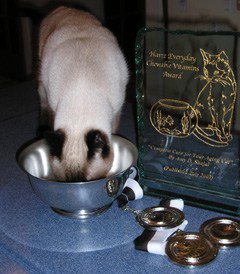 I’ve been fortunate to win a few of the CWA-sponsored awards. While the cash is terrific (writers are notoriously underpaid!), the kudos from colleagues and other pros in the field goes even further. Having one of these awards on your resume actually helps land future writing jobs.
I’ve been fortunate to win a few of the CWA-sponsored awards. While the cash is terrific (writers are notoriously underpaid!), the kudos from colleagues and other pros in the field goes even further. Having one of these awards on your resume actually helps land future writing jobs.
CWA also sponsors an annual writing conference. This year the conference is held in conjunction with the BlogPaws Conference, and event that brings together beginning to professional bloggers with a passion for pets. That makes it possible for pet professionals, show people, products manufacturers and media attending the event to also attend the educational sessions. Anybody who’s anyone in the world of cats or dogs (or ferrets, birds, bunnies, even pigs!) will be at this event in June. Yes, it’s a long time away, but now you can mark your calendar well in advance!
Seminars offer help to beginning-to-advance writers, and are presented by a wide range of professionals. Editors in attendance welcome meeting with aspiring article and book authors. In fact, I have personally sold more articles than I can count, and four pet books as a direct result of attending this conference.
Because our members have specialized interest in all-things-pets, seminars and panel discussions in the past have included such varied topics as laws pertaining to animals; veterinary issues and hot topics to cover in the news; and shelter/animal welfare issues. I’ve just confirmed speakers on topics ranging from self-publishing to New York publishing, marketing your work, submitting proposals and more. BlogPaws speakers will offer a plethora of info on blogging, SEO, state of the industry, marketing and more. Stay tuned!
In addition to the great writing seminars, a pet book signing event will be held during the conference featuring many attending authors and their latest books. If you love pets–and you do or you wouldn’t read this blog; and if you are now writing or would like to learn more; consider entering the contest and/or attending the CWA conference and/or entering the contest. Check out this video from contest chair Arden Moore with more information. Hope to see you there!
I love hearing from you, so please share comments and questions. Do you have an ASK AMY question you’d like answered? Do you have a new kitten and need answers? Stay up to date on all the latest just subscribe the blog, “like” me on Facebook, and sign up for Pet Peeves newsletter. Stay up to date with the latest book give aways and appearances related to my THRILLERS WITH BITE!
January 1, 2016
New Year Pet Resolutions 2016 Edition

A goal, courtesy of a gift from my brilliant and always astute (and never wrong) Dad.
It’s 2016 and this year I resolved to NOT make resolutions. Instead, I’m making “goals.” Rather than an end-accomplishment, I’d rather strive for the destination but try to enjoy the journey along the way. In my experience, some of the side-roads along the journey prove to be as much if not more rewarding than the final accomplishment. How about you?
A new year is a time for reflection on the past. This year has been incredibly challenging for my family on multiple fronts, and I’m in the process of reevaluating many things. But I’m also grateful for all of our blessings, and for the opportunity to share my work with other pet-loving peeps.
In the past two weeks, I’ve had two new books released, after much gnashing of virtual teeth. The third book in my thriller series SHOW AND TELL released December 22, and I’m delighted it’s already receiving some glowing reviews. Just so you know, it took nearly a year to write…and rewrite…and rewrite…due to some of those aforementioned unexpected side-roads.
 Then last week on December 29 a purring-new cat care book released, CAT FACTS: The Pet Parent’s A-to-Z Home Care Encyclopedia. I can honestly say it took me nearly 25 years to write this book. This massive illustrated book is a compilation of my years as a pet care and behavior advocate and reporter, and my wish is that it helps cat lovers better care for their special kitties. Oh, and no worries for the wagging pets—DOG FACTS is in the works and hopefully won’t take another 25 years to accomplish (there’s one of my goals!).
Then last week on December 29 a purring-new cat care book released, CAT FACTS: The Pet Parent’s A-to-Z Home Care Encyclopedia. I can honestly say it took me nearly 25 years to write this book. This massive illustrated book is a compilation of my years as a pet care and behavior advocate and reporter, and my wish is that it helps cat lovers better care for their special kitties. Oh, and no worries for the wagging pets—DOG FACTS is in the works and hopefully won’t take another 25 years to accomplish (there’s one of my goals!).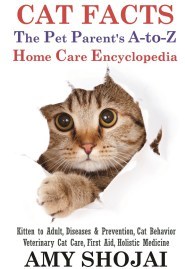
None of this would be possible without my furry muses. It’s become a tradition to take stock of the past year from a pets’-eye-view, too, and the year to come.
The Magical-dawg had a renewed episode of licking his paws nekkid, and we’re still struggling to resolve that. It’s aggravated by stress, and I have no doubt Magic is feeling and reacting to my own stress so my goal is to DE-stress more to help us both. Magic is now nine, and has clearly begun to slow down and show his age.
Seren-kitty will be 20 in February, but has had no issue with schnorkles this year. She’s become more active and demanding of attention–a good thing! and I attribute that to the arrival of Karma-Kat. She’s become more tolerant of him and Magic, but is forced to move her furry tail to stay out the delinquent cat’s reach. She still makes sure they both know she’s the boss. In my CAT FACTS book the age comparison chart places her in the geriatric range, with a human age equivalent in her late 80s. Mee-wow!
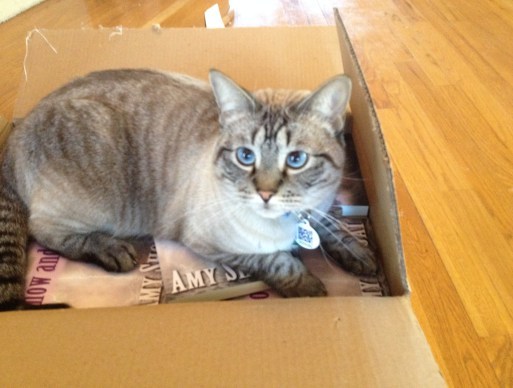 Karma has grown from a lanky adolescent kitten into a hefty man-kat eager for a game of tag, chase, “towel skiing” and treats. He’s my nighttime pillow-share buddy, and the delight of Magic, makes Seren grumpy, and keeps us humans laughing.
Karma has grown from a lanky adolescent kitten into a hefty man-kat eager for a game of tag, chase, “towel skiing” and treats. He’s my nighttime pillow-share buddy, and the delight of Magic, makes Seren grumpy, and keeps us humans laughing.
So here are New Year’s Resolutions from Magic, Seren and Karma with commentary by Amy.
Magic: “I will train my humans to spend more time playing. And petting me. ”
Amy: He still insists on fetch. All the time. I mean ALL the time! both inside the house and out, even though his older legs have slowed down on the return time. So my goal is to toss toys shorter distances lower to the ground so he won’t have to leap, and use only the soft stuffed toys to cut down on household damage.
Karma: “I will train my humans to leave open the treat drawer so I can help myself.”
Amy: We’ve had to put an extra door stop on the pantry door to keep him from opening it and chewing through the dog food bag. Any treats must be kept behind doors or in drawers or he carries off the packaging and empties the bag. So my goal is to continue offering Karma cat-healthy treats kept in cat-proofed containers.
Seren: “I will stand on table tops, hassocks and Amy’s lap and cry and yowl to get another taste of yummy canned food.”
Amy: She’s been on a therapeutic food for a couple of years, but started stealing from Karma’s bowl—and at her age, we figure anything she wants is legal. As a result, she’s eating more, gained a bit of weight, and looks and acts better. Besides, Karma steals HER food, too. Yelling for food also gets her attention, a big coup for her to diss Karma. My goal is to keep Karma otherwise engaged so that Seren can enjoy her food without harassment from the delinquent cat.
Magic: “I will kill all squeakers and chew sticky-out wrong parts on toys. And keep Karma from stealing my toys.”
Amy: He amputates teddy-bear ears, and SQUEEEEEKS toys forever to drive us crazy. Magic got to keep the squeakie “Willoughby” bark toys from my role in the recent Mary Poppins show…but Karma steals them now, too. I will again seek to find a Magic-proof squeaky stuffed toy—been looking for years now. And remember to supervise so Magic doesn’t steal Karma’s toys, or vice versa.
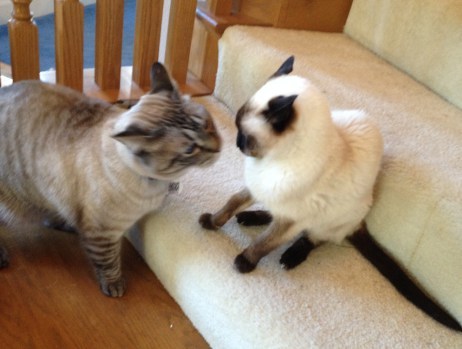 Karma: “I will stalk and tease and pounce at Magic so he chases me, and turn Seren into my personal wrestle-toy to make the humans yell, what fun!”
Karma: “I will stalk and tease and pounce at Magic so he chases me, and turn Seren into my personal wrestle-toy to make the humans yell, what fun!”
Amy: Karma takes great delight in teasing Magic and getting him into trouble. He also gets on top of Seren to wrestle her, and at over twice her weight, turns her into a pancake of kitty frustration. My goal is to play interactive chase games with Karma each day to give him the exercise, attention and fun he craves and deserves.
Seren: “I will train Amy there’s more to nine lives than paw-tapping and staring at a boxy computer-thing. Like catnip. And whisker-kisses.”
Karma: “I will train Amy that playing with cats is more fun than anything else.”
Magic: “I will train Amy that there’s no such thing as too many treats. But time together is even better.”
Amy: My goal is to listen to my furry muses. What about you?
I love hearing from you, so please share comments and questions. Do you have an ASK AMY question you’d like answered? Do you have a new kitten and need answers? Stay up to date on all the latest just subscribe the blog, “like” me on Facebook, and sign up for Pet Peeves newsletter. Stay up to date with the latest book give aways and appearances related to my THRILLERS WITH BITE!
New Year Pet Resolutions 2016 Edition

A goal, courtesy of a gift from my brilliant and always astute (and never wrong) Dad.
It’s 2016 and this year I resolved to NOT make resolutions. Instead, I’m making “goals.” Rather than an end-accomplishment, I’d rather strive for the destination but try to enjoy the journey along the way. In my experience, some of the side-roads along the journey prove to be as much if not more rewarding than the final accomplishment. How about you?
A new year is a time for reflection on the past. This year has been incredibly challenging for my family on multiple fronts, and I’m in the process of reevaluating many things. But I’m also grateful for all of our blessings, and for the opportunity to share my work with other pet-loving peeps.
In the past two weeks, I’ve had two new books released, after much gnashing of virtual teeth. The third book in my thriller series SHOW AND TELL released December 22, and I’m delighted it’s already receiving some glowing reviews. Just so you know, it took nearly a year to write…and rewrite…and rewrite…due to some of those aforementioned unexpected side-roads.
 Then last week on December 29 a purring-new cat care book released, CAT FACTS: The Pet Parent’s A-to-Z Home Care Encyclopedia. I can honestly say it took me nearly 25 years to write this book. This massive illustrated book is a compilation of my years as a pet care and behavior advocate and reporter, and my wish is that it helps cat lovers better care for their special kitties. Oh, and no worries for the wagging pets—DOG FACTS is in the works and hopefully won’t take another 25 years to accomplish (there’s one of my goals!).
Then last week on December 29 a purring-new cat care book released, CAT FACTS: The Pet Parent’s A-to-Z Home Care Encyclopedia. I can honestly say it took me nearly 25 years to write this book. This massive illustrated book is a compilation of my years as a pet care and behavior advocate and reporter, and my wish is that it helps cat lovers better care for their special kitties. Oh, and no worries for the wagging pets—DOG FACTS is in the works and hopefully won’t take another 25 years to accomplish (there’s one of my goals!).
None of this would be possible without my furry muses. It’s become a tradition to take stock of the past year from a pets’-eye-view, too, and the year to come.
The Magical-dawg had a renewed episode of licking his paws nekkid, and we’re still struggling to resolve that. It’s aggravated by stress, and I have no doubt Magic is feeling and reacting to my own stress so my goal is to DE-stress more to help us both. Magic is now nine, and has clearly begun to slow down and show his age.
Seren-kitty will be 20 in February, but has had no issue with schnorkles this year. She’s become more active and demanding of attention–a good thing! and I attribute that to the arrival of Karma-Kat. She’s become more tolerant of him and Magic, but is forced to move her furry tail to stay out the delinquent cat’s reach. She still makes sure they both know she’s the boss. In my CAT FACTS book the age comparison chart places her in the geriatric range, with a human age equivalent in her late 80s. Mee-wow!
 Karma has grown from a lanky adolescent kitten into a hefty man-kat eager for a game of tag, chase, “towel skiing” and treats. He’s my nighttime pillow-share buddy, and the delight of Magic, makes Seren grumpy, and keeps us humans laughing.
Karma has grown from a lanky adolescent kitten into a hefty man-kat eager for a game of tag, chase, “towel skiing” and treats. He’s my nighttime pillow-share buddy, and the delight of Magic, makes Seren grumpy, and keeps us humans laughing.
So here are New Year’s Resolutions from Magic, Seren and Karma with commentary by Amy.
Magic: “I will train my humans to spend more time playing. And petting me. ”
Amy: He still insists on fetch. All the time. I mean ALL the time! both inside the house and out, even though his older legs have slowed down on the return time. So my goal is to toss toys shorter distances lower to the ground so he won’t have to leap, and use only the soft stuffed toys to cut down on household damage.
Karma: “I will train my humans to leave open the treat drawer so I can help myself.”
Amy: We’ve had to put an extra door stop on the pantry door to keep him from opening it and chewing through the dog food bag. Any treats must be kept behind doors or in drawers or he carries off the packaging and empties the bag. So my goal is to continue offering Karma cat-healthy treats kept in cat-proofed containers.
Seren: “I will stand on table tops, hassocks and Amy’s lap and cry and yowl to get another taste of yummy canned food.”
Amy: She’s been on a therapeutic food for a couple of years, but started stealing from Karma’s bowl—and at her age, we figure anything she wants is legal. As a result, she’s eating more, gained a bit of weight, and looks and acts better. Besides, Karma steals HER food, too. Yelling for food also gets her attention, a big coup for her to diss Karma. My goal is to keep Karma otherwise engaged so that Seren can enjoy her food without harassment from the delinquent cat.
Magic: “I will kill all squeakers and chew sticky-out wrong parts on toys. And keep Karma from stealing my toys.”
Amy: He amputates teddy-bear ears, and SQUEEEEEKS toys forever to drive us crazy. Magic got to keep the squeakie “Willoughby” bark toys from my role in the recent Mary Poppins show…but Karma steals them now, too. I will again seek to find a Magic-proof squeaky stuffed toy—been looking for years now. And remember to supervise so Magic doesn’t steal Karma’s toys, or vice versa.
 Karma: “I will stalk and tease and pounce at Magic so he chases me, and turn Seren into my personal wrestle-toy to make the humans yell, what fun!”
Karma: “I will stalk and tease and pounce at Magic so he chases me, and turn Seren into my personal wrestle-toy to make the humans yell, what fun!”
Amy: Karma takes great delight in teasing Magic and getting him into trouble. He also gets on top of Seren to wrestle her, and at over twice her weight, turns her into a pancake of kitty frustration. My goal is to play interactive chase games with Karma each day to give him the exercise, attention and fun he craves and deserves.
Seren: “I will train Amy there’s more to nine lives than paw-tapping and staring at a boxy computer-thing. Like catnip. And whisker-kisses.”
Karma: “I will train Amy that playing with cats is more fun than anything else.”
Magic: “I will train Amy that there’s no such thing as too many treats. But time together is even better.”
Amy: My goal is to listen to my furry muses. What about you?
I love hearing from you, so please share comments and questions. Do you have an ASK AMY question you’d like answered? Do you have a new kitten and need answers? Stay up to date on all the latest just subscribe the blog, “like” me on Facebook, and sign up for Pet Peeves newsletter. Stay up to date with the latest book give aways and appearances related to my THRILLERS WITH BITE!
December 30, 2015
CAT FACTS Pounces Off the Shelves: Your EVERYTHING Cat Book!
 IT’S HERE! Those who took advantage of the pre-order Kindle sale already have that version, and yesterday the print book was also released. Can I hear a “meee-WOW!”
IT’S HERE! Those who took advantage of the pre-order Kindle sale already have that version, and yesterday the print book was also released. Can I hear a “meee-WOW!”
After adding all the pictures, tips boxes and charts, the finished book totals 546 pages, and includes a detailed index to help folks find anything you want to know about your cat’s care, behavior, first aid, and more. I’ve included some screen-shots of the proof of the book, to give you a taste of what to expect. You can find the print book at this link.
The Kindle version is here (already ranking in top 20 or higher in Cat Breeds, and Small Animal Medicine!)
Hope you’ll post a review, too. Please share this post with anyone you think might benefit from an all-encompassing book on cat care, behavior, vet info, holistic treatments and first aid. Oh, and did I mention there’s a breeds-at-a-glance chart, too? *s*





 I love hearing from you, so please share comments and questions. Do you have an ASK AMY question you’d like answered? Do you have a new kitten and need answers? Stay up to date on all the latest just subscribe the blog, “like” me on Facebook, and sign up for Pet Peeves newsletter. Stay up to date with the latest book give aways and appearances related to my THRILLERS WITH BITE!
I love hearing from you, so please share comments and questions. Do you have an ASK AMY question you’d like answered? Do you have a new kitten and need answers? Stay up to date on all the latest just subscribe the blog, “like” me on Facebook, and sign up for Pet Peeves newsletter. Stay up to date with the latest book give aways and appearances related to my THRILLERS WITH BITE!
December 26, 2015
CAT FACTS, Your Everything Book for #Cats and Kittens!
KINDLE PRE-ORDER DISCOUNT $4.99!
CAT FACTS is the culmination of my more than 25 years as a pet journalist, with information gleaned from the 400 veterinarians I’ve had the pleasure to interview over the years. With more than 200 entries, double that number of charts, illustrations and cute kitty pictures, you’ll find first aid, natural healing tips, home care and veterinary information at the tip of your paws.
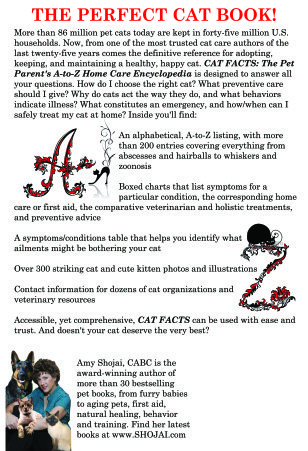 You can find the Ebook version on all platforms (the iBookStore already has the book for preorder here) but the $4.99 discount is exclusive to Kindle. The 550 page trade paperback ($19.99) will release next week as well.
You can find the Ebook version on all platforms (the iBookStore already has the book for preorder here) but the $4.99 discount is exclusive to Kindle. The 550 page trade paperback ($19.99) will release next week as well.
Now is the time to subscribe to Pet Peeves because I’ll be giving away paw-tographed copies of the book to several subscribers! Please subscribe here...and tell your cat-loving friends!
…And if you are a blogger/reviewer/cat lover, please feel free to message me about possible review copies.
I love hearing from you, so please share comments and questions. Do you have an ASK AMY question you’d like answered? Do you have a new kitten and need answers? Stay up to date on all the latest just subscribe the blog, “like” me on Facebook, and sign up for Pet Peeves newsletter. Stay up to date with the latest book give aways and appearances related to my THRILLERS WITH BITE!

